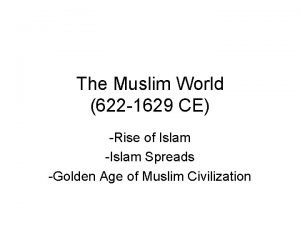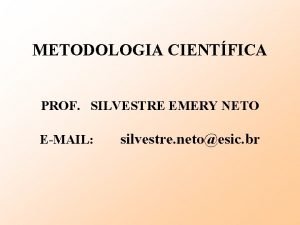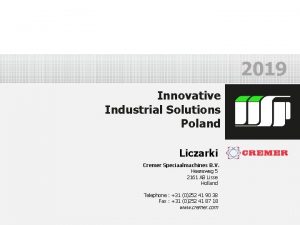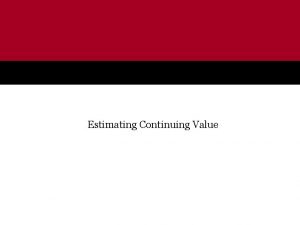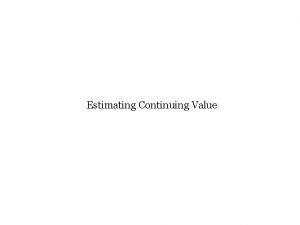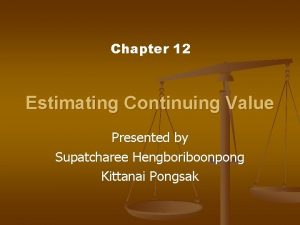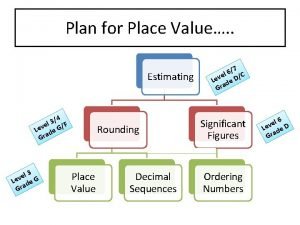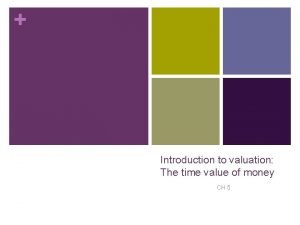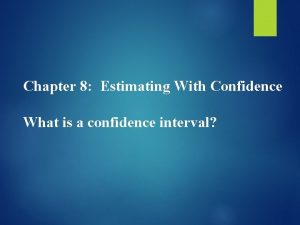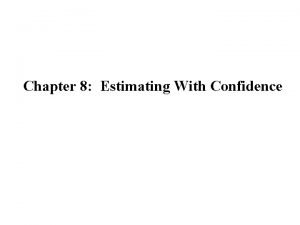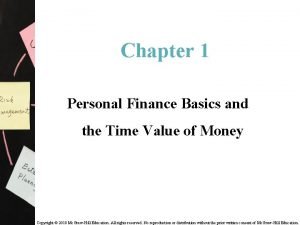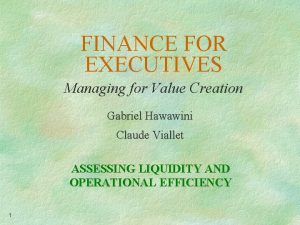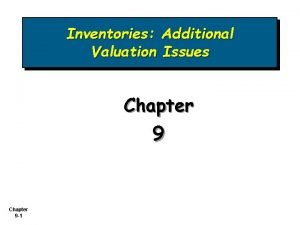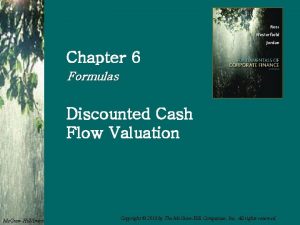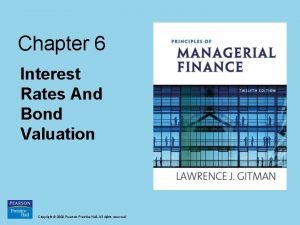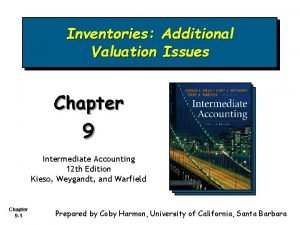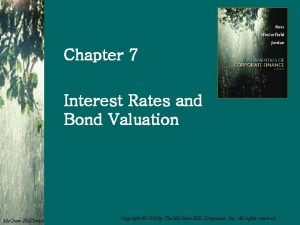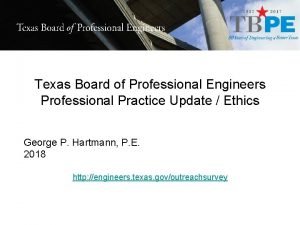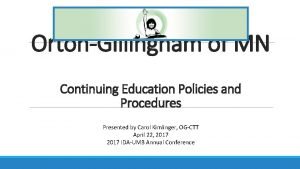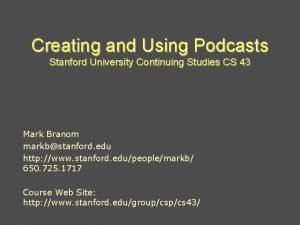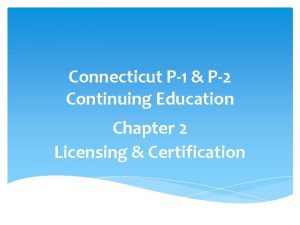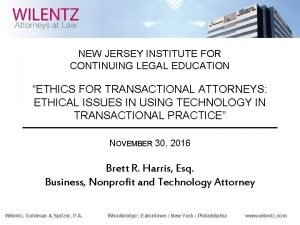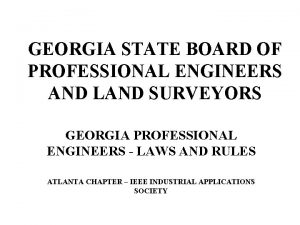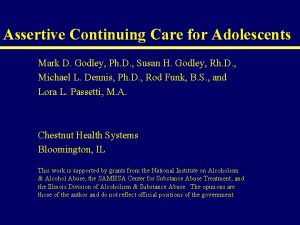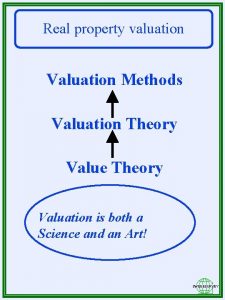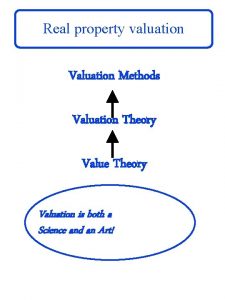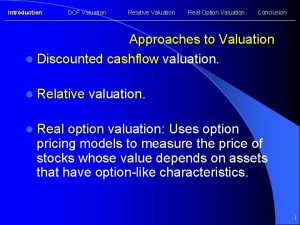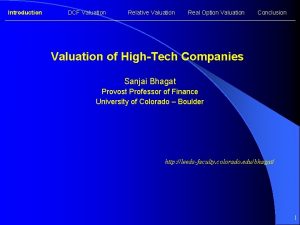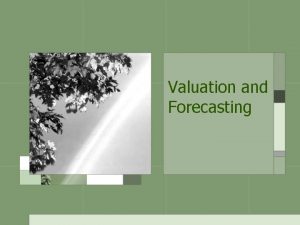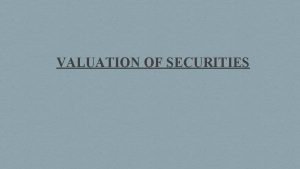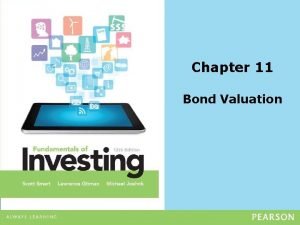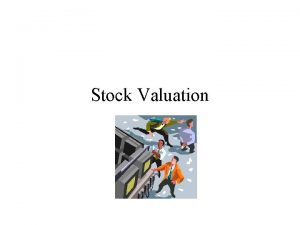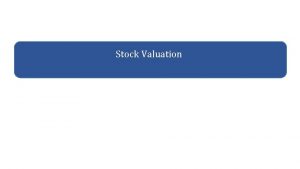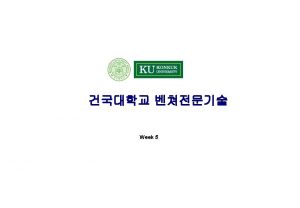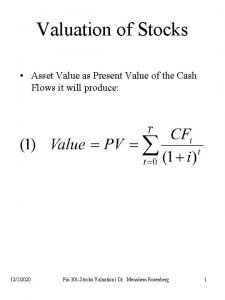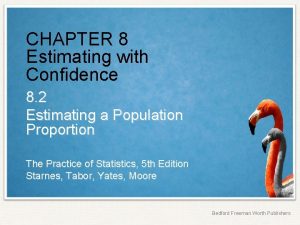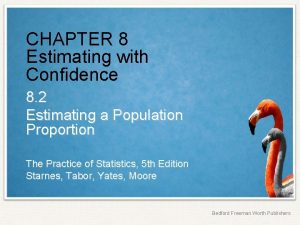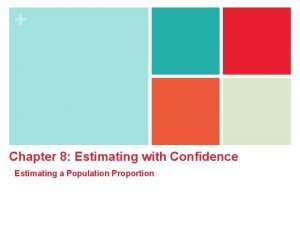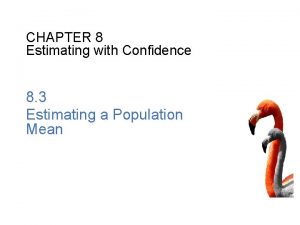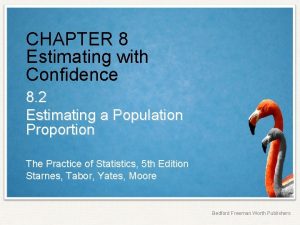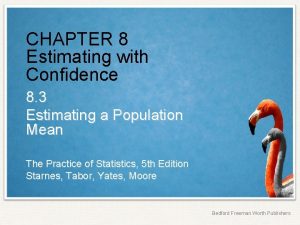Valuation Chapter 12 Estimating Continuing Value Finance 622


































- Slides: 34

Valuation Chapter 12 Estimating Continuing Value Finance 622

Agenda • Estimating Continuing Value • Continuing Value Formula for DCF Valuation • Continuing Value Formula for Economic Profit • Interpretation of Continuing Value • Parameters for Continuing Value Variables • Common Pitfalls • Evaluating Other Approaches Valuation

Value = PV of CF during the Explicit Forecast Period + PV of CF after the Explicit Forecast Period

Continuing Value = PV of the Expected CF after the Explicit Forecast Period

Continuing Value Formula for DCF Valuation DFC Continuing Value= NOPLATt+1(1 -g/ROICI) WACC-g NOPLAT = The normalized level of NOPLAT in the first year after the explicit forecast period. g = The expected growth rate in NOPLAT in perpetuity. ROIC = The expected rate of return on net new investment. WACC = The weighted aver cost of capital.

Assumptions for the Continuing Value Formula for DCG Valuation The company earns constant margins, maintains a constant capital turnover, and thus earns a constant return on existing invested capital. The company’s revenues and NOPLAT grow at a constant rate and the company invests the same proportion of its gross cash flow in its business each year. The company earns a constant return on all new investments

Simple Formula for a Cash Flow Perpetuity that grows at a Constant Rate CV = FCFT+1 WACC-g FCFT+1 = The normalized level of free cash flow in the first year after the explicit forecast period.

Free Cash Flow in terms of NOPLAT and Investment Rate Free Cash Flow= NOPLAT x (1 -IR) IR = The investment rate, or the percentage of NOPLAT reinvested in the business each year.

Relationship between IR, g and ROICI g = ROICI x IR which is = IR = g ROICI

Build with the Free Cash Flow Definition FCF = NOPLAT x 1 - g ROICI

Also Know As Value-Driver Formula Because the input variables of Growth, ROIC and WACC are the key drives of Value

Growth rate in NOPLAT & Free Cash Flow = 6% ROICi = 12% and WACC = 11% Long Range Forecast of 150 years CV= 50/1. 11+53/(1. 11)2+56/(1. 11)3+… 50(1. 06)149/(1. 11)150=999 Growing Free Cash Flow Perpetuity Formula CV= 50/11% - 6% = 1000 Value-Driver Formula CV= 100(1 -6%/12%) / 11%-6%=1000

Recommended Continuing Value Formula for Economic Profit Valuation With the economic profit approach, the continuing value does not represent the value of the company after the explicit forecast period. Instead, it is the incremental value over the company’s invested capital at the end of the explicit forecast period

CV formula for Economic Profit Valuation Value = Invested capital at the beginning of the period + Present value of forecasted economic profit during explicit forecast period + Present value of forecasted economic profit after the explicit forecast period

CV = Economic profit. T+1 + (NOPLATT+1)(g/ROICI)(ROICI – WACC) WACC (WACC – g) Economic Profit. T+1= The normalized economic profit in the first year after the explicit forecast period. NOPLAT = The normalized NOPLAT in the first year after the explicit forecast period. g = The expected growth rate in NOPLAT in perpetuity. ROICI = The expected rate of return on new investments. WACC = The weighted average cost of capital.

Issues in the Interpretation of Continuing Value The length of the forecast doe not affect the Value of the Company. I’m so Confused about ROIC. When is Value Created?

Total Value Calculations 5 years

Total Value Calculations 10 years

Confusion about ROIC Confusion can occur with the concept of competitive advantage period when companies will earn returns above the cost of capital for a period of time, followed by a decline in the cost of capital. It is dangerous to link it to the length of the forecast. As it has been shown that there is no connection between the length of the forecast and the value of the company. Remember, the value-driver formula is based on incremental returns on capital, not company wide average returns. If you assume that incremental returns in the CV period will just equal the cost of capital, you are not assuming that the return on total capital (old and new) will equal the cost of capital. The return on the old capital will continue to earn the returns it is projected to earn in the last forecast period. In other words, the company’s competitive advantage period has not come to an end once you reach the continuing value period.

Exhibit 12. 4 shows the implied average ROIC assuming that projected CV growth is 4. 5%, the return on base capital is 18%, the return on incremental capital is 10%, and the WACC is 10%. The average return on all capital declines gradually. From its starting point of 18% , it declines to 14% (the halfway point to the incremental ROIC) after 11 years. It reaches 12% after 23 years and 11% after 37 years.

When is Value Created? Below, it appears the 85% of the company’s value come form the Continuing Value.

A Business Components Approach Looks at the negative cash flow when invested in a new business line and its appearance of long range value.

Economic Profit Model Valuation is the same from all three methods.

Estimating Parameters for Continuing Value Variables NOPLAT The base level of NOPLAT should reflect a normalized level of earnings for the company at the midpoint of its business cycle. Revenues should generally reflect the continuation of the trends in the last forecast year adjusted to the midpoint of the business cycle. Operating costs should be based on sustainable margin levels, and taxes should be based on long-term expected rates. Free Cash Flow First, estimate the base level of NOPLAT as described above. Although NOPLAT is usually based on the last forecast year’s results, the prior year’s level of investment is probably not a good indicator of the sustainable amount of investment needed for growth in the continuing value period. Carefully estimate how much investment will be required to sustain the forecasted growth rate. Often the forecasted growth in the CV Period is lower so the amount of investment should be proportionately smaller amount of NOPLAT.

Estimating Parameters for Continuing Value Variables WACC The weighted average cost of capital should incorporate a sustainable capital structure and an underlying estimate of business risk consistent with expected industry conditions. Investment Rate The investment rate is not explicitly in the formula, but it equals ROIC divided by growth. Make sure that the investment rate can be explained in light of industry economics

Common Pitfalls Naïve Base-Year Extrapolation A continual increase in working capital as a percentage of sales and therefore significantly understating the value of the company (increase in working capital is too large for the increase in sales)

Common Pitfalls Naïve Over-conservatism Do not assume that the incremental return on capital in the continuing value period will equal the cost of capital. In doing so, one is apt not to forecast growth rate since growth nether adds nor destroys value. Case in point are companies with proprietary products who can command high returns on invested capital. Purposeful Over-conservatism The size and uncertainty of Continuing Value leads to over-conservatism. But uncertainty is a two edged sword, it can cut both ways. Careful development of scenarios (Venture Sims. TM) are critical elements of any valuation.

Other DCF Approaches Convergence Formula implies zero growth. This is not the case. It means that growth will add nothing to value, because the return associated with growth just equals the cost of capital. Start with Value-driver Formula CV=NOPLATT+1(1 -g/ROICI)/WACC-g Assume ROICI=WACC (incremental invested capital = the cost of capital) CV=NOPLATT+1(1 -g/WACC)/WACC-g = CV= NOPLATT+1 (WACC-g)/(WACC) /WACC-g Canceling the term WACC-g leaves a simple formula CV= NOPLATT+1/WACC

Other DCF Approaches Aggressive Formula Assumes that earnings in the Continuing Value period will grow at some rate, most often the inflation rate. The conclusion is then drawn that earnings should be discounted at the real WACC rather than the nominal WACC. Here, g is the inflation rate. This formula can substantially over states Continuing Value because it assumes that NOPLAT can grow without any incremental capital investment: any growth will probably require additional working capital and fixed assets. Assume that ROIC approaches infinity: CV= NOPLATT+1(1 -g/ROICI) /WACC-g ROIC ∞ therefore g/ROICI 0 CV= NOPLATT+1(1 -0)/WACC-g = CV= NOPLATT+1/WACC-g

Non-Cash Flow Approaches Liquidation-Value Approach sets the continuing value equal to an estimate of the proceeds from the sale of the assets of the business, after paying off liabilities at the end of the explicit forecast period. Replacement-Cost Approach sets the continuing value equal to the expected cost to replace the company’s assets. Price-To-Earnings Ratio Approach assumes the company will be worth some multiple of its future earnings in the continuing period. Market-To-Book Ratio Approach assumes the company will be worth some multiple of its book value, often the same as its current multiple or the multiple of comparable companies.

Non-Cash Flow Approaches Liquidation-Value Approach sets the continuing value equal to an estimate of the proceeds from the sale of the assets of the business, after paying off liabilities at the end of the explicit forecast period. Replacement-Cost Approach sets the continuing value equal to the expected cost to replace the company’s assets. Price-To-Earnings Ratio Approach assumes the company will be worth some multiple of its future earnings in the continuing period. Market-To-Book Ratio Approach assumes the company will be worth some multiple of its book value, often the same as its current multiple or the multiple of comparable companies.

Any Questions?

No?

Thank you for your time and consideration.
 Valuation of fixed income securities or valuation of bonds
Valuation of fixed income securities or valuation of bonds 622 ce
622 ce Emery 622
Emery 622 Liczarka do tabletek
Liczarka do tabletek How to calculate noplat
How to calculate noplat What is continuing value
What is continuing value Noplat
Noplat Place value and estimating
Place value and estimating Apa itu value creation
Apa itu value creation Introduction to valuation the time value of money
Introduction to valuation the time value of money Chapter 8 estimating with confidence
Chapter 8 estimating with confidence Chapter 8 estimating with confidence
Chapter 8 estimating with confidence Chapter 8 estimating with confidence
Chapter 8 estimating with confidence Personal finance basics and the time value of money
Personal finance basics and the time value of money Finance for executives: managing for value creation
Finance for executives: managing for value creation Chapter 7 interest rates and bond valuation
Chapter 7 interest rates and bond valuation Chapter 9 inventories additional valuation issues
Chapter 9 inventories additional valuation issues Chapter 6 discounted cash flow valuation
Chapter 6 discounted cash flow valuation How to find the price of a bond
How to find the price of a bond Chapter 6 interest rates and bond valuation
Chapter 6 interest rates and bond valuation Lower of cost or market
Lower of cost or market Chapter 7 interest rates and bond valuation
Chapter 7 interest rates and bond valuation Chapter 6 interest rates and bond valuation
Chapter 6 interest rates and bond valuation San diego continuing education north city campus
San diego continuing education north city campus Board of professional engineers texas
Board of professional engineers texas Ra 10912 known as
Ra 10912 known as Imslec certification
Imslec certification Stanford continuing studies certificate
Stanford continuing studies certificate Kylene perras
Kylene perras Connecticut plumbing license
Connecticut plumbing license Uq eap
Uq eap New jersey institute for continuing legal education
New jersey institute for continuing legal education Ga professional engineer
Ga professional engineer Life long education artinya
Life long education artinya Assertive continuing care
Assertive continuing care

